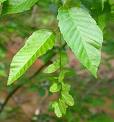American Hornbeam Tree Information
Images of American Hornbeam:






American Hornbeam grows in the following 36 states and provinces:
Alabama, Arkansas, Colorado, Connecticut, Delaware, Florida, Georgia, Illinois, Indiana, Iowa, Kansas, Kentucky, Louisiana, Maine, Maryland, Massachusetts, Michigan, Minnesota, Mississippi, Missouri, New Hampshire, New Jersey, New York, North Carolina, Ohio, Oklahoma, Ontario, Pennsylvania, Rhode Island, South Carolina, Tennessee, Texas, Vermont, Virginia, West Virginia, WisconsinInformation about American Hornbeam:
The Carpinus Caroliniana is commonly known as the American Hornbeam, Blue-beech, Ironwood, Muscletree as well as Water-beech.
The currently accepted scientific name for American hornbeam is Carpinus caroliniana Walt. (Betulaceae) . Infrataxa are : Carpinus caroliniana ssp. caroliniana Carpinus caroliniana ssp. virginiana (Marshall) FurlowThe range of American hornbeam extends from central Maine west to southwestern Quebec, southeastern Ontario, northern Michigan, and northern Minnesota; south to central Iowa and eastern Texas; and east to central Florida .American hornbeam primarily occurs in the understory of bottomland mixed-hardwood forests, but also occurs in dry-mesic upland hardwood forests . Understory associates of American hornbeam in all parts of its range include eastern hophornbeam (Ostrya virginiana), flowering dogwood (Cornus florida), sassafras (Sassafras albidum), witch-hazel (Hamamelis virginiana), serviceberries (Amelanchier spp.), and speckled alder (Alnus rugosa). In the northern parts of its range, understory associates include striped maple (Acer pennsylvanicum), mountain maple (A. spicatum), red mulberry (Morus rubra), pawpaw (Asimina triloba), serviceberries, and eastern redbud (Cercis canadensis). Southern associates include magnolias (Magnolia spp.), deciduous holly (Ilex decidua), American holly (I. opaca), winged elm (Ulmus alata), sweetbay (Magnolia virginiana), water-elm (Planera aquatica), parsley hawthorn (Crataegus marshallii), riverflat hawthorn (C. opaca), common persimmon (Diospyros virginiana), and Carolina laurelcherry (Prunus caroliniana) .Some of the information provided here is attributed to:Sullivan, Janet. 1994. Carpinus caroliniana. In: Fire Effects Information System, [Online]. U.S. Department of Agriculture, Forest Service, Rocky Mountain Research Station, Fire Sciences Laboratory (Producer). , available at the USDA Fire Effects Information System (FEIS) website